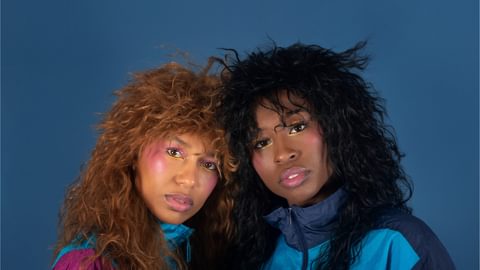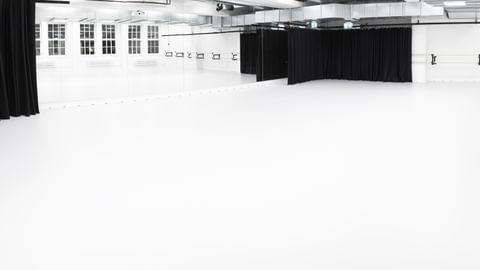
Marianna Henriksson & Anna Mustonen: Eros
-
6 performances
6.10-13.10.2022
-
Duration
1 h 20 min, no intermission
-
Venue
Erkko Hall
-
Tickets
42/38/21 €
Performances
Thu 6.10.2022 at 19.00
Sat 8.10.2022 at 19.00
Sun 9.10.2022 at 15.00
Tue 11.10.2022 at 19.00
Wed 12.10.2022 at 19.00
Thu 13.10.2022 at 19.00
Post-performance discussion on Tue, Oct 11
Duration 1 h, no intermission
NOTE!
For ticket related questions, please contact Zodiak.
In Eros, Marianna Henriksson and Anna Mustonen continue their collaboration in bringing together the music of early Baroque and new dance. Eight musicians, five dancers and five singers reach towards each other at the large stage of Erkko Hall of Dance House Helsinki.
It is a reach that never quite arrives, bittersweet.
The ancient Greek word eros contains the notion of lack. Eros is the desire for something that is not present. As I attain it, my longing ceases. Distance is the prerequisite for erotic desire; it is moved by distance. Eros inserts itself between us and densifies the space between.
…electrified by desire so that they touch not touching -
In the performance, dance and music are often intertwined, sometimes at different tracks, continuously sharing the same space. Eight musicians, five dancers and five singers surrender to the fluctuating vibrations between dance and music. The dance and music yearn for each other, gently reaching towards one another.
- the way they intersect may feel like eros to you.
The choreography of the piece lies in the desire to approach, in the gestures of reaching out. It is dance from the moment touch has not yet taken place. It is about approaching when tentativeness and tension are allowed to be seen and the other is not taken into possession.
In early Italian Baroque music, eros is the prolonged desire of dissonances and suspensions to resolve towards consonances. Eros lies in the meaning of song lyrics intertwined with abrasions, projections and frictional reachings-out of the music. Sound fluctuates between us as vibration in the air, reaches the ear canals, and enters the body. A slight movement takes place.
For in this dance the people do not move. Desire moves. Eros is a verb.
Music: Biagio Marini – Claudio Monteverdi – Giovanni Felice Sances – Barbara Strozzi
Quotes: Anne Carson: Eros the Bittersweet (1986)
The performance is also a part of Finnish Baroque Orchestra’s and Helsinki Early Music Festival’s programmes in the autumn 2022.
The event is organized by Zodiak - Center for New Dance
Camera and editing: Alisa Javits
Music: Biagio Marini (1594–1663): Capriccio per sonare il violino con tre corde à modo di lira (excerpt).
Performed by Anne Pekkala, violin; Louna Hosia, cello; Anna Rinta-Rahko, violone; Eero Palviainen, theorbo, Marianna Henriksson, harpsichord; Jani Sunnarborg, organ
Recording and editing: Jussi Lehtopuu
Assembling and concept
Marianna Henriksson, Anna Mustonen
Choreography
Anna Mustonen
Musical director, harpsichord and organ
Marianna Henriksson
Dancers
Hanna Ahti, Mikko Hyvönen, Anna Kupari, Pie Kär, Eleni Pierides
Soprano
Sirkku Rintamäki, Tuuli Lindeberg
Alto
Teppo Lampela
Tenor
Juho Punkeri
Bass
Jussi Lehtipuu
Finnish Baroque Orchestra
violin
Anne Pekkala and Hannu Vasara
viola
Hanna Pakkala
cello
Louna Hosia
violone
Anna Rinta-Rahko
dulcian
Jani Sunnarborg
lute and baroque guitar
Eero Palviainen
Dramaturge
Masi Tiitta
Costume design
Piia Rinne
Lighting and set design
Heikki Paasonen
Sound design
Timo Kurkikangas
Producer
Riikka Thitz
i dolci
Internship / dancer
Iiris Miettinen
Danish National School of Performing Arts / Den Danske Scenekunstskole
Assistant for lighting design
Erno Seppälä
(University of Arts Helsinki, Theatre Academy, VÄS)
Airbrushing
Eija Koponen
Dressmaking
Veera Vuorisalo and Anneli Partanen
Costume of Jussi Lehtipuu
Henrik Vibskov
Production
i dolci, Zodiak – Center for New Dance, Finnish Baroque Orchestra, Helsinki Early Music Festival
Supported by
Jenny and Antti Wihuri Foundation, Kone Foundation, Uusimaa Regional Fund of the Finnish Cultural Foundation, Arts Promotion Centre Finland
Residence
Santarcangelo dei Teatri (IT) / Finnish Cultural Foundation













